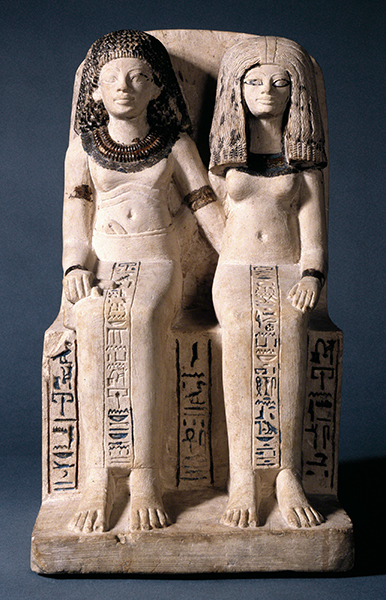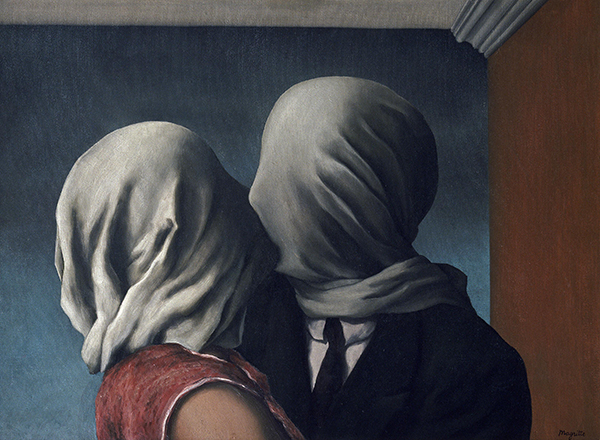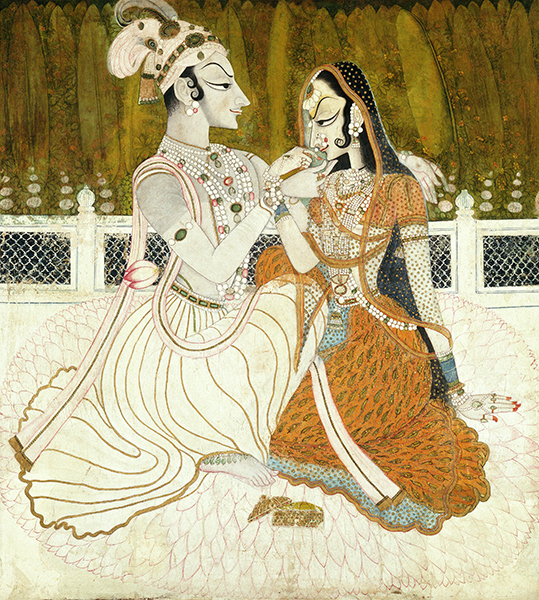Romance Awareness Month: Egypt, Rene Magritte, Mughal Period
As is obvious from art even from the distant ancient world, the ideas of romance, affection, and love were not inventions of modern humans. And there are many ideas through art history about how to depict them.
 |
| Ancient Egypt, Pair Statue of Nebsen and His Wife Nebet-ta, ca. 1400–1352 BCE. Painted limestone, 15 ¾" x 8 5/8" x 9 7/16" (40 x 22 x 24 cm). © 2021 Brooklyn Museum. (BMA-555) |
The majority of Egyptian art was concerned with the elaborate funeral ritual. Because Egyptians believed that their lives would continue unchanged after death, their tombs were decorated with scenes of what would occur in the afterlife. This included depictions of the offerings they expected their kin to supply for the other world.
This type of plinth sculpture—called a pair statue—was devised by sculptors in the Old Kingdom (ca. 2700–2200) for inclusion in tombs of the wealthy. It is covered in prayers and formulas to enable its subjects to successfully transition to the afterlife.
Nebsen, a royal treasury scribe, and Nebet-ta, a temple of Isis singer, take New Kingdom (1550-1069 BCE) affection to a new level. The sculpture is unusual in that the husband's arm enfolds his wife in a tender gesture, as does her arm of him. That gesture was usually reserved for the wife to indicate her obedience to her husband. Their arms are exaggerated in physical length so that the composition achieves the dual embrace.
The New Kingdom resulted in the greatest period of cultural, artistic, and political expansion and flourish in Egypt's long history. It was also the period when the Egyptians expanded their territory to its farthest extent, including Assyria, Babylon, and Palestine.
Stylistically, Egyptian art changed very little for more than 2500 years. The formulas established for the depiction of the human figure and physical objects were established during the Old Kingdom (ca. 2650-1986 BCE) until Egypt was made a Roman province in the first 30 years BCE. Although the preferred (fashionable) types of stelae and reliefs changed from dynasty to dynasty, the forms remained static.
 |
| René Magritte (1898–1967, Belgium), The Lovers (II), 1928. Oil on canvas, 21 1/4” x 28 7/8” (54 x 73.4 cm). Courtesy of the Museum of Modern Art, New York. © 2021 C. Herscovici, Brussels/Artists Rights Society (ARS), New York. (MOMA-P3114maars) |
Imagery was more important than style for many of the Surrealists. René Magritte's paintings feature an academic palette that present mysterious subjects. Unlike Salvador Dalí's (1904–1989) work, the imagery is not drawn from Magritte's personal recollections, but rather is a combination of elements of the physical world put together to confound the viewer's perception on the meaning of "realistic" art.
The Lovers (II) took the cliché of the movie love scene and rendered it farcical with the shrouded heads unable to connect. This negates any voyeuristic pleasure the viewer may have derived from it. The veil corresponds to the Surrealist interest in masks or disguises that hide the surface reality of an object, thus transforming physical reality. The subject may also reference the illustrations for tawdry pulp fiction or thriller stories that influenced Magritte's work.
In Europe, Surrealism ultimately arose from the Dada movement in reaction to the failure of mainstream Western culture (the logical world) in its disastrous First World War (1914–1918). Surrealist artists believed in the superiority of the subconscious because it was not ruled by societal norms dictated by "reason" or morality, thus nor should art be. They believed that the dream world possessed a vitality, freedom, and poetry lacking in civilization. Surrealism rejected objective interpretation of subject matter in favor of intuitive or dream imagery.
Magritte was a leading Belgian Surrealist. Trained academically in Brussels, he was introduced to Dada by a poet friend of his brother and was later introduced to the Metaphysical Fantasy work of Giorgio de Chirico (1888–1978). De Chirico's work was a pivotal influence on Magritte. He began producing Surrealist paintings in 1926. In 1927, he moved to Paris, where he exhibited with the Surrealist artists and even composed essays on the nature of Surrealist art.
 |
| India, Radha and Krsna, from Kishangarh, Rajasthan, ca. 1750. Opaque watercolor and gold leaf on cotton, 40 ¾" x 37" (103.5 x 94 cm). © 2021 Philadelphia Museum of Art. (PMA-2736) |
The trademark style of the depictions of Radha and Krsna were the work of the artist Nihal Chand (1710–1782), a friend of the Maharaja of Kishangarh (Raj Singh, 1674–1748). It is thought that the features of Radha were based on the raja's mistress.
The mannered style Chand developed is seen in this depiction of the celestial couple on the terrace of a palace garden. The long neck, pointed chin, hook-like almond-shaped eyes, whiplash eyebrows, and thin lips are typical of Kishangarh depictions of Krsna and Radha during this period. Versions of this style exist in certain schools of contemporary Indian art. The style is often parodied as "typical" Indian art by some contemporary artists.
Painting in India flourished as early as 200 BCE in the form of fresco decoration in Buddhist cave complexes such as Ajanta. There is little extant Hindu wall painting from the same period except for fragments at Ellora and Thanjavur. The Mughal Period (1526–1857) ushered in Persian and European influence in painting, as well as an interest in scenes of everyday life of nobles and common people alike.
While large parts of India were still ruled by the Mughal Empire, the British ruled major parts of India through the British East India Company (a trading corporation) from 1600 to 1858. There were remnants of Mughal style painting in Kishangarh by the beginning of the 1700s. However, the standout school of painting emerged during the middle of the 1700s under the rule of Raja Savant Singh (died 1757). He was a poet and ardent worshipper of Lord Krsna in his appearance on Earth as the divine lover.


Comments